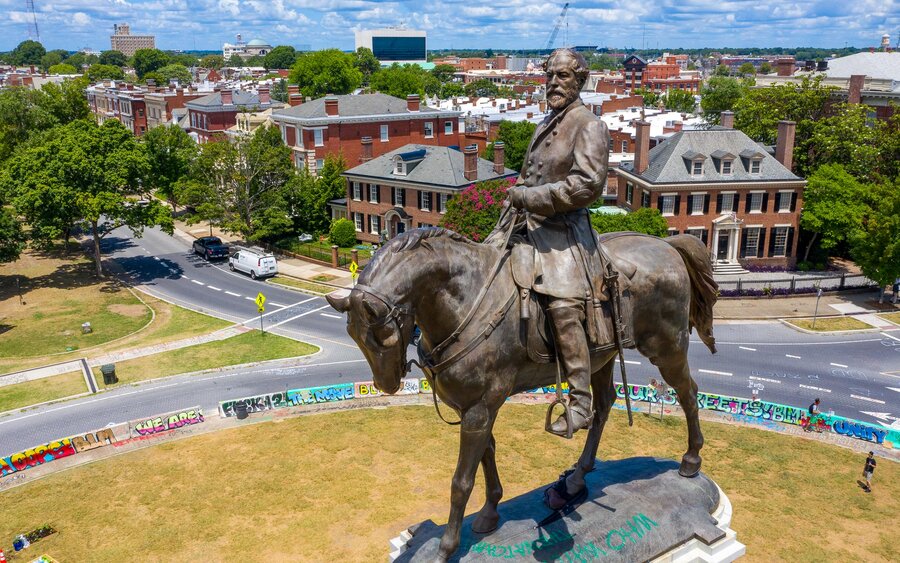How Richmond plans to remove its Robert E. Lee statue
Loading...
| Richmond, Va.
When the bronze equestrian statue of Gen. Robert E. Lee arrived by rail in Richmond from Paris in 1890, it took 10,000 men, women, and children to haul its pieces more than a mile to the site where the towering monument was erected as a tribute to a Confederate hero.
Now, 130 years later, conservation experts who plan to relocate, yet preserve, the statue face the intricate logistics of disassembling and transporting it to a storage facility. They must also ensure worker safety amid heated public debate over whether the statue is an important piece of Southern heritage or a symbol of white supremacy and racism.
Virginia Gov. Ralph Northam announced plans to remove the 13-ton sculpture in June, after the death of George Floyd sparked a nationwide protest movement over racial inequality and police brutality. Mr. Floyd, a Black man, died in May after a white Minneapolis police officer put his knee on Mr. Floyd's neck for several minutes.
The plan to remove the monument – an imposing, 21-foot tall bronze likeness of General Lee on a horse that sits atop a granite pedestal nearly twice that high – has been halted at least temporarily by a lawsuit. But Mr. Northam has vowed to quickly take down the state-owned statue if and when a judge lifts an injunction barring its removal.
Now covered by graffiti, the Lee monument has become the epicenter of the protest movement in Richmond, a former capital of the Confederacy that has moved slowly in shedding vestiges of its past. Four other city-owned Confederate statues on Richmond's historic Monument Avenue were taken down last month in response to sometimes-violent protests.
B.R. Howard Conservation, a Pennsylvania company that specializes in art conservation and historic preservation projects, has developed a plan that calls for removing 16 bronze pins to separate the statue from its base, removing the harness and reins of General Lee's horse, then attaching padded straps and using a crane to lift it and lower it to the ground.
A 100-ton crane brought in from Connecticut was used to remove large statues of Confederate Gens. J.E.B. Stuart and Stonewall Jackson, said Paul DiPasquale, a sculptor who designed and built Richmond's monument to Black tennis legend Arthur Ashe and served as a consultant on the removals of the Stuart and Jackson statues. A similarly large crane is expected to be used to take down the Lee statue.
Because of its enormous size, the statue will then be cut into three pieces so that it can fit under highway overpasses with height restrictions of between 13 1/2 to 14 feet as it is taken to an undisclosed storage site. The Northam administration has said it will seek public input on the statue's future.
Mr. DiPasquale said taking down the statue could present some challenges, but can be done safely while preserving the artistic integrity of the sculpture, one of the largest and most recognizable Confederate statues in the United States.
"Lifting it is a challenge, where to cut it is a challenge and then how to load it, you want it to travel safely," he said.
Mr. DiPasquale said there is strong public interest in witnessing the monuments come down because of the historical significance and symbolism of removing Confederate icons.
"Once removed, it severs the history of why it's been there and why it's coming down," he said. "That is a milestone in our cultural experience, and I think whether it's conscious or not, that's why people want to be there."
The plan calls for cutting the statue along existing folds and seams to minimize any damage. Based on written accounts describing the assembly of the sculpture in 1890, the first section to be cut will include the cast base and the legs of Lee's horse; the second section, the body and head of the horse; and the third, the figure of Gen. Lee, from the waist up.
The conservator recommends putting up a partition so that the work can be done "away from the view of the public for their safety and protection of the crew."
Confederate monument removals have provoked high tensions elsewhere in the U.S.
In New Orleans, contractors involved in the removal of the city's Confederate monuments in 2017 faced threats. They often wore bulletproof vests, helmets, and face coverings to shield their identities as the work took place, sometimes in the overnight hours.
Then-Mayor Mitch Landrieu proposed the monuments' removal after the 2015 massacre of nine black parishioners at a South Carolina church by a gunman who was an avowed racist and brandished Confederate battle flags in photos.
B.R. Howard has a separate plan for disassembling the Lee monument's 40-foot high pedestal, which may contain a time capsule, although Mr. Northam's administration has not yet made a decision about that part of the monument.
The plan calls for photographing or creating a three-dimensional scan of the pedestal. An inventory will be done to identify and locate hundreds of granite blocks and carved decorative elements. Then, workers will cut mortar joints to separate the individual pieces. All of the disassembled granite blocks will be placed on pallets and layered with padding to protect them during relocation and storage.
The Lee statue was created by the internationally renowned French sculptor Marius-Jean-Antonin Mercie and is considered a "masterpiece," according to its nomination to the National Register of Historic Places, where it has been listed since 2007.
This story was reported by The Associated Press.
Editor’s note: As a public service, the Monitor has removed the paywall for all our coronavirus coverage. It’s free.





